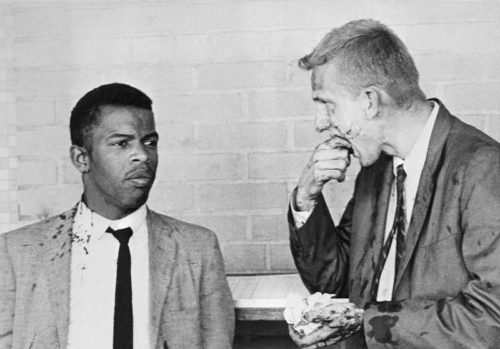White Supremacist Ideas Have Historical Roots In U.S. Christianity
Share
Explore Our Galleries
Breaking News!
Today's news and culture by Black and other reporters in the Black and mainstream media.
Ways to Support ABHM?
By Tom Gjelten, npr.org

Two blood-splattered Freedom Riders, John Lewis and James Zwerg, stand together after segregationists attacked them in the early 1960s in Montgomery, Ala. Lewis, then a young civil rights activist, would later become a member of Congress from Georgia.
Bettmann Archive/Getty Images
When a young Southern Baptist pastor named Alan Cross arrived in Montgomery, Ala., in January 2000, he knew it was where the Rev. Martin Luther King, Jr. had his first church and where Rosa Parks helped launched the famous bus boycott, but he didn’t know some other details of the city’s role in civil rights history.
The more he learned, the more troubled he became by one event in particular: the savage attack in May 1961 on a busload of Black and white Freedom Riders who had traveled defiantly together to Montgomery in a challenge to segregation. Over the next 15 years, Cross, who is white, would regularly take people to the old Greyhound depot in Montgomery to highlight what happened that spring day.
“They pull in right here, on the side,” Cross said, standing in front of the depot. “And it was quiet when they got here. But then once they start getting off the bus, around 500 people come out – men, women and children. Men were holding the Freedom Riders back, and the women were hitting them with their purses and holding their children up to claw their faces.” Some of the men carried lead pipes and baseball bats. Two of the Freedom Riders, the civil rights activist John Lewis and a white ally, James Zwerg, were beaten unconscious.
Though he had grown up in Mississippi and was familiar with the history of racial conflict in the South, Cross was horrified by the story of the 1961 attack on the Freedom Riders. Montgomery was known as a city of churches. Fresh out of seminary, Cross had come there to preach the gospel of Jesus Christ.
“Why didn’t white Christians show up?” he recalled wondering…
Full article here
More Breaking News here
ABHM galleries here
Birmingham Sunday here









Comments Are Welcome
Note: We moderate submissions in order to create a space for meaningful dialogue, a space where museum visitors – adults and youth –– can exchange informed, thoughtful, and relevant comments that add value to our exhibits.
Racial slurs, personal attacks, obscenity, profanity, and SHOUTING do not meet the above standard. Such comments are posted in the exhibit Hateful Speech. Commercial promotions, impersonations, and incoherent comments likewise fail to meet our goals, so will not be posted. Submissions longer than 120 words will be shortened.
See our full Comments Policy here.